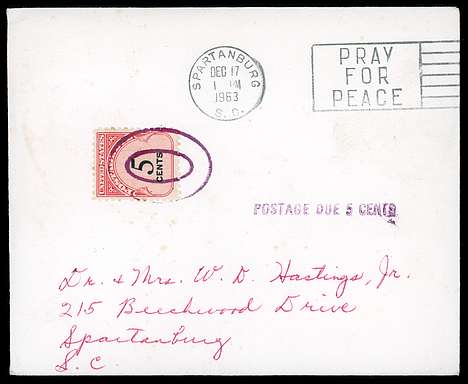| Postage Due Stamps |
| Item # |
|
US$ | ||
| 246041 |
Scott #J92 [1959 4c red and black Postage Due] (VF) on somewhat unusual August 1960 small-size business cover (window envelope) mailed locally within Kansas City, Missouri. Four folds on the envelope, none affecting the stamp. The envelope, probably containing an invoice or statement, was accidentally mailed without postage. According to regulations at the time, the post office correctly attempted delivery with postage due charged to the recipient. The 4c postage due stamp was affixed and canceled (undated roller device), as was the practice, before delivery was attempted. There is a penciled notation "no Resp" (no response) with carrier initials, and then a magenta handstamped date of "AUG 26 1960" again with the carrier initials (probably from a second attempt). The cover then received TWO DIFFERENT magenta "POINTING HAND" markings, one "RETURNED TO Sender / KANSAS CITY, MO." and the other "RETURNED TO WRITER / UNCLAIMED". At that time, a magenta "VOID" handstamp was applied to the 4c postage due stamp, indicating that the recipient did not pay the 4c due amount. Also with "KANSAS CITY / MO." September 6 1960 machine cancel on reverse. "9-6" was written in red in the lower right corner -- this was likely a filing system "trigger date" at which time the item would be returned to the sender if delivery was not successful. When returned to the original sender, current regulations stated that the original sender had to pay the postage due amount. However, the cover bears no indication of such payment by the original sender, resulting in (at least) one of four possibilities: 1) The original sender refused to accept the return and to pay the due amount; it is unclear to me if that was even possible. 2) A postal worker could have simply let it pass unpaid since the original sender was a "good customer". 3) A postal employee could have collected the 4c due amount and simply not put the canceled postage on the envelope, but perhaps gave the canceled postage directly to the original sender; 4) The explanation that I think is most likely: The original sender, a large business office, received several postage due items per day/week and the post office bundled them with a facing sheet that bore the total of all postage due stamps for the entire bundle. From time to time I encounter such facing sheets from this time period. While in many ways ordinary, this example illustrates the application of multiple regulations and processes. While such covers are not "rare" we do not often see them offered in the market. ACTUAL item. |
12.00 |
||
| 246042 |
Scott #J93 [1959 5c red and black Postage Due] (VF) on December 17 1963 small-size greeting card size cover mailed locally within Spartanburg, South Carolina SC, with "PRAY / FOR / PEACE" machine cancellation. Accidentally mailed without postage. According to regulations at the time, the post office correctly attempted delivery with postage due charged to the recipient. The 5c postage due stamp was affixed and canceled (undated magenta double oval), as was the practice, before delivery was attempted. Also clearly handstamped in violet "POSTAGE DUE 5 CENTS". Neat and attractive example. ACTUAL item. |
8.00 |